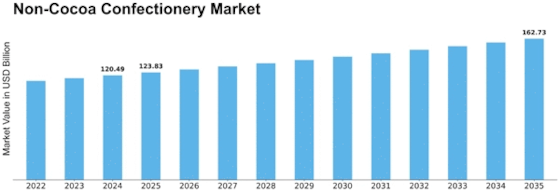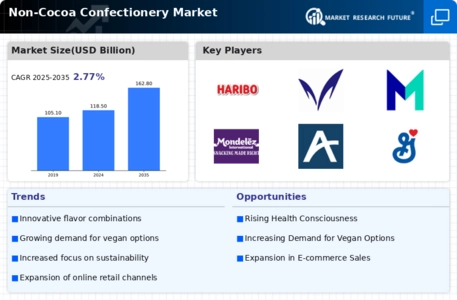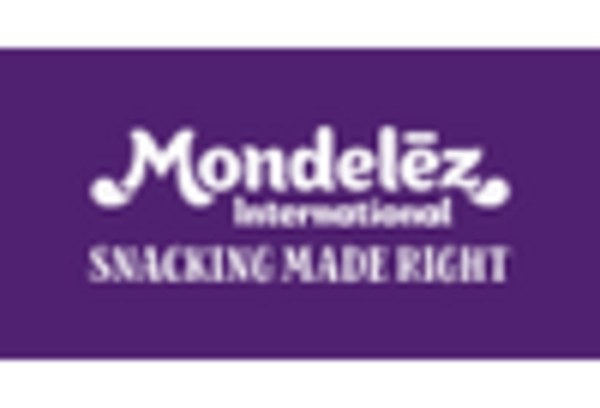-
EXECUTIVE SUMMARY
-
Market Overview
-
Key Findings
-
Market Segmentation
-
Competitive Landscape
-
Challenges and Opportunities
-
Future Outlook
-
MARKET INTRODUCTION
-
Definition
-
Scope of the study
- Research Objective
- Assumption
- Limitations
-
RESEARCH METHODOLOGY
-
Overview
-
Data Mining
-
Secondary Research
-
Primary Research
- Primary Interviews and Information Gathering Process
- Breakdown of Primary Respondents
-
Forecasting Model
-
Market Size Estimation
- Bottom-Up Approach
- Top-Down Approach
-
Data Triangulation
-
Validation
-
MARKET DYNAMICS
-
Overview
-
Drivers
-
Restraints
-
Opportunities
-
MARKET FACTOR ANALYSIS
-
Value chain Analysis
-
Porter's Five Forces Analysis
- Bargaining Power of Suppliers
- Bargaining Power of Buyers
- Threat of New Entrants
- Threat of Substitutes
- Intensity of Rivalry
-
COVID-19 Impact Analysis
- Market Impact Analysis
- Regional Impact
- Opportunity and Threat Analysis
-
GLOBAL NON-COCOA CONFECTIONERY MARKET, BY PRODUCT TYPE (USD BILLION)
-
Gum
-
Hard Candy
-
Jelly Candy
-
Mints
-
Marzipan
-
GLOBAL NON-COCOA CONFECTIONERY MARKET, BY DISTRIBUTION CHANNEL (USD BILLION)
-
Supermarkets/Hypermarkets
-
Convenience Stores
-
Online Retail
-
Specialty Stores
-
GLOBAL NON-COCOA CONFECTIONERY MARKET, BY CONSUMER AGE GROUP (USD BILLION)
-
Children
-
Teenagers
-
Adults
-
Elderly
-
GLOBAL NON-COCOA CONFECTIONERY MARKET, BY FLAVOR PROFILE (USD BILLION)
-
Fruity
-
Sour
-
Minty
-
Spicy
-
GLOBAL NON-COCOA CONFECTIONERY MARKET, BY REGIONAL (USD BILLION)
-
North America
- US
- Canada
-
Europe
- Germany
- UK
- France
- Russia
- Italy
- Spain
- Rest of Europe
-
APAC
- China
- India
- Japan
- South Korea
- Malaysia
- Thailand
- Indonesia
- Rest of APAC
-
South America
- Brazil
- Mexico
- Argentina
- Rest of South America
-
MEA
- GCC Countries
- South Africa
- Rest of MEA
-
COMPETITIVE LANDSCAPE
-
Overview
-
Competitive Analysis
-
Market share Analysis
-
Major Growth Strategy in the Global Non-Cocoa Confectionery Market
-
Competitive Benchmarking
-
Leading Players in Terms of Number of Developments in the Global Non-Cocoa Confectionery Market
-
Key developments and growth strategies
- New Product Launch/Service Deployment
- Merger & Acquisitions
- Joint Ventures
-
Major Players Financial Matrix
- Sales and Operating Income
- Major Players R&D Expenditure. 2023
-
COMPANY PROFILES
-
Haribo
- Financial Overview
- Products Offered
- Key Developments
- SWOT Analysis
- Key Strategies
-
Supercandies
- Financial Overview
- Products Offered
- Key Developments
- SWOT Analysis
- Key Strategies
-
Meiji
- Financial Overview
- Products Offered
- Key Developments
- SWOT Analysis
- Key Strategies
-
Mars
- Financial Overview
- Products Offered
- Key Developments
- SWOT Analysis
- Key Strategies
-
Mondelez International
- Financial Overview
- Products Offered
- Key Developments
- SWOT Analysis
- Key Strategies
-
UIB
- Financial Overview
- Products Offered
- Key Developments
- SWOT Analysis
- Key Strategies
-
Arcor
- Financial Overview
- Products Offered
- Key Developments
- SWOT Analysis
- Key Strategies
-
General Mills
- Financial Overview
- Products Offered
- Key Developments
- SWOT Analysis
- Key Strategies
-
Cloetta
- Financial Overview
- Products Offered
- Key Developments
- SWOT Analysis
- Key Strategies
-
Hershey
- Financial Overview
- Products Offered
- Key Developments
- SWOT Analysis
- Key Strategies
-
Brach's
- Financial Overview
- Products Offered
- Key Developments
- SWOT Analysis
- Key Strategies
-
Perfetti Van Melle
- Financial Overview
- Products Offered
- Key Developments
- SWOT Analysis
- Key Strategies
-
Nestle
- Financial Overview
- Products Offered
- Key Developments
- SWOT Analysis
- Key Strategies
-
Tootsie Roll Industries
- Financial Overview
- Products Offered
- Key Developments
- SWOT Analysis
- Key Strategies
-
Ferrero
- Financial Overview
- Products Offered
- Key Developments
- SWOT Analysis
- Key Strategies
-
APPENDIX
-
References
-
Related Reports
-
LIST OF TABLES
-
LIST OF ASSUMPTIONS
-
NORTH AMERICA GLOBAL NON-COCOA CONFECTIONERY MARKET SIZE ESTIMATES & FORECAST, BY PRODUCT TYPE, 2019-2032 (USD BILLIONS)
-
NORTH AMERICA GLOBAL NON-COCOA CONFECTIONERY MARKET SIZE ESTIMATES & FORECAST, BY DISTRIBUTION CHANNEL, 2019-2032 (USD BILLIONS)
-
NORTH AMERICA GLOBAL NON-COCOA CONFECTIONERY MARKET SIZE ESTIMATES & FORECAST, BY CONSUMER AGE GROUP, 2019-2032 (USD BILLIONS)
-
NORTH AMERICA GLOBAL NON-COCOA CONFECTIONERY MARKET SIZE ESTIMATES & FORECAST, BY FLAVOR PROFILE, 2019-2032 (USD BILLIONS)
-
NORTH AMERICA GLOBAL NON-COCOA CONFECTIONERY MARKET SIZE ESTIMATES & FORECAST, BY REGIONAL, 2019-2032 (USD BILLIONS)
-
US GLOBAL NON-COCOA CONFECTIONERY MARKET SIZE ESTIMATES & FORECAST, BY PRODUCT TYPE, 2019-2032 (USD BILLIONS)
-
US GLOBAL NON-COCOA CONFECTIONERY MARKET SIZE ESTIMATES & FORECAST, BY DISTRIBUTION CHANNEL, 2019-2032 (USD BILLIONS)
-
US GLOBAL NON-COCOA CONFECTIONERY MARKET SIZE ESTIMATES & FORECAST, BY CONSUMER AGE GROUP, 2019-2032 (USD BILLIONS)
-
US GLOBAL NON-COCOA CONFECTIONERY MARKET SIZE ESTIMATES & FORECAST, BY FLAVOR PROFILE, 2019-2032 (USD BILLIONS)
-
US GLOBAL NON-COCOA CONFECTIONERY MARKET SIZE ESTIMATES & FORECAST, BY REGIONAL, 2019-2032 (USD BILLIONS)
-
CANADA GLOBAL NON-COCOA CONFECTIONERY MARKET SIZE ESTIMATES & FORECAST, BY PRODUCT TYPE, 2019-2032 (USD BILLIONS)
-
CANADA GLOBAL NON-COCOA CONFECTIONERY MARKET SIZE ESTIMATES & FORECAST, BY DISTRIBUTION CHANNEL, 2019-2032 (USD BILLIONS)
-
CANADA GLOBAL NON-COCOA CONFECTIONERY MARKET SIZE ESTIMATES & FORECAST, BY CONSUMER AGE GROUP, 2019-2032 (USD BILLIONS)
-
CANADA GLOBAL NON-COCOA CONFECTIONERY MARKET SIZE ESTIMATES & FORECAST, BY FLAVOR PROFILE, 2019-2032 (USD BILLIONS)
-
CANADA GLOBAL NON-COCOA CONFECTIONERY MARKET SIZE ESTIMATES & FORECAST, BY REGIONAL, 2019-2032 (USD BILLIONS)
-
EUROPE GLOBAL NON-COCOA CONFECTIONERY MARKET SIZE ESTIMATES & FORECAST, BY PRODUCT TYPE, 2019-2032 (USD BILLIONS)
-
EUROPE GLOBAL NON-COCOA CONFECTIONERY MARKET SIZE ESTIMATES & FORECAST, BY DISTRIBUTION CHANNEL, 2019-2032 (USD BILLIONS)
-
EUROPE GLOBAL NON-COCOA CONFECTIONERY MARKET SIZE ESTIMATES & FORECAST, BY CONSUMER AGE GROUP, 2019-2032 (USD BILLIONS)
-
EUROPE GLOBAL NON-COCOA CONFECTIONERY MARKET SIZE ESTIMATES & FORECAST, BY FLAVOR PROFILE, 2019-2032 (USD BILLIONS)
-
EUROPE GLOBAL NON-COCOA CONFECTIONERY MARKET SIZE ESTIMATES & FORECAST, BY REGIONAL, 2019-2032 (USD BILLIONS)
-
GERMANY GLOBAL NON-COCOA CONFECTIONERY MARKET SIZE ESTIMATES & FORECAST, BY PRODUCT TYPE, 2019-2032 (USD BILLIONS)
-
GERMANY GLOBAL NON-COCOA CONFECTIONERY MARKET SIZE ESTIMATES & FORECAST, BY DISTRIBUTION CHANNEL, 2019-2032 (USD BILLIONS)
-
GERMANY GLOBAL NON-COCOA CONFECTIONERY MARKET SIZE ESTIMATES & FORECAST, BY CONSUMER AGE GROUP, 2019-2032 (USD BILLIONS)
-
GERMANY GLOBAL NON-COCOA CONFECTIONERY MARKET SIZE ESTIMATES & FORECAST, BY FLAVOR PROFILE, 2019-2032 (USD BILLIONS)
-
GERMANY GLOBAL NON-COCOA CONFECTIONERY MARKET SIZE ESTIMATES & FORECAST, BY REGIONAL, 2019-2032 (USD BILLIONS)
-
UK GLOBAL NON-COCOA CONFECTIONERY MARKET SIZE ESTIMATES & FORECAST, BY PRODUCT TYPE, 2019-2032 (USD BILLIONS)
-
UK GLOBAL NON-COCOA CONFECTIONERY MARKET SIZE ESTIMATES & FORECAST, BY DISTRIBUTION CHANNEL, 2019-2032 (USD BILLIONS)
-
UK GLOBAL NON-COCOA CONFECTIONERY MARKET SIZE ESTIMATES & FORECAST, BY CONSUMER AGE GROUP, 2019-2032 (USD BILLIONS)
-
UK GLOBAL NON-COCOA CONFECTIONERY MARKET SIZE ESTIMATES & FORECAST, BY FLAVOR PROFILE, 2019-2032 (USD BILLIONS)
-
UK GLOBAL NON-COCOA CONFECTIONERY MARKET SIZE ESTIMATES & FORECAST, BY REGIONAL, 2019-2032 (USD BILLIONS)
-
FRANCE GLOBAL NON-COCOA CONFECTIONERY MARKET SIZE ESTIMATES & FORECAST, BY PRODUCT TYPE, 2019-2032 (USD BILLIONS)
-
FRANCE GLOBAL NON-COCOA CONFECTIONERY MARKET SIZE ESTIMATES & FORECAST, BY DISTRIBUTION CHANNEL, 2019-2032 (USD BILLIONS)
-
FRANCE GLOBAL NON-COCOA CONFECTIONERY MARKET SIZE ESTIMATES & FORECAST, BY CONSUMER AGE GROUP, 2019-2032 (USD BILLIONS)
-
FRANCE GLOBAL NON-COCOA CONFECTIONERY MARKET SIZE ESTIMATES & FORECAST, BY FLAVOR PROFILE, 2019-2032 (USD BILLIONS)
-
FRANCE GLOBAL NON-COCOA CONFECTIONERY MARKET SIZE ESTIMATES & FORECAST, BY REGIONAL, 2019-2032 (USD BILLIONS)
-
RUSSIA GLOBAL NON-COCOA CONFECTIONERY MARKET SIZE ESTIMATES & FORECAST, BY PRODUCT TYPE, 2019-2032 (USD BILLIONS)
-
RUSSIA GLOBAL NON-COCOA CONFECTIONERY MARKET SIZE ESTIMATES & FORECAST, BY DISTRIBUTION CHANNEL, 2019-2032 (USD BILLIONS)
-
RUSSIA GLOBAL NON-COCOA CONFECTIONERY MARKET SIZE ESTIMATES & FORECAST, BY CONSUMER AGE GROUP, 2019-2032 (USD BILLIONS)
-
RUSSIA GLOBAL NON-COCOA CONFECTIONERY MARKET SIZE ESTIMATES & FORECAST, BY FLAVOR PROFILE, 2019-2032 (USD BILLIONS)
-
RUSSIA GLOBAL NON-COCOA CONFECTIONERY MARKET SIZE ESTIMATES & FORECAST, BY REGIONAL, 2019-2032 (USD BILLIONS)
-
ITALY GLOBAL NON-COCOA CONFECTIONERY MARKET SIZE ESTIMATES & FORECAST, BY PRODUCT TYPE, 2019-2032 (USD BILLIONS)
-
ITALY GLOBAL NON-COCOA CONFECTIONERY MARKET SIZE ESTIMATES & FORECAST, BY DISTRIBUTION CHANNEL, 2019-2032 (USD BILLIONS)
-
ITALY GLOBAL NON-COCOA CONFECTIONERY MARKET SIZE ESTIMATES & FORECAST, BY CONSUMER AGE GROUP, 2019-2032 (USD BILLIONS)
-
ITALY GLOBAL NON-COCOA CONFECTIONERY MARKET SIZE ESTIMATES & FORECAST, BY FLAVOR PROFILE, 2019-2032 (USD BILLIONS)
-
ITALY GLOBAL NON-COCOA CONFECTIONERY MARKET SIZE ESTIMATES & FORECAST, BY REGIONAL, 2019-2032 (USD BILLIONS)
-
SPAIN GLOBAL NON-COCOA CONFECTIONERY MARKET SIZE ESTIMATES & FORECAST, BY PRODUCT TYPE, 2019-2032 (USD BILLIONS)
-
SPAIN GLOBAL NON-COCOA CONFECTIONERY MARKET SIZE ESTIMATES & FORECAST, BY DISTRIBUTION CHANNEL, 2019-2032 (USD BILLIONS)
-
SPAIN GLOBAL NON-COCOA CONFECTIONERY MARKET SIZE ESTIMATES & FORECAST, BY CONSUMER AGE GROUP, 2019-2032 (USD BILLIONS)
-
SPAIN GLOBAL NON-COCOA CONFECTIONERY MARKET SIZE ESTIMATES & FORECAST, BY FLAVOR PROFILE, 2019-2032 (USD BILLIONS)
-
SPAIN GLOBAL NON-COCOA CONFECTIONERY MARKET SIZE ESTIMATES & FORECAST, BY REGIONAL, 2019-2032 (USD BILLIONS)
-
REST OF EUROPE GLOBAL NON-COCOA CONFECTIONERY MARKET SIZE ESTIMATES & FORECAST, BY PRODUCT TYPE, 2019-2032 (USD BILLIONS)
-
REST OF EUROPE GLOBAL NON-COCOA CONFECTIONERY MARKET SIZE ESTIMATES & FORECAST, BY DISTRIBUTION CHANNEL, 2019-2032 (USD BILLIONS)
-
REST OF EUROPE GLOBAL NON-COCOA CONFECTIONERY MARKET SIZE ESTIMATES & FORECAST, BY CONSUMER AGE GROUP, 2019-2032 (USD BILLIONS)
-
REST OF EUROPE GLOBAL NON-COCOA CONFECTIONERY MARKET SIZE ESTIMATES & FORECAST, BY FLAVOR PROFILE, 2019-2032 (USD BILLIONS)
-
REST OF EUROPE GLOBAL NON-COCOA CONFECTIONERY MARKET SIZE ESTIMATES & FORECAST, BY REGIONAL, 2019-2032 (USD BILLIONS)
-
APAC GLOBAL NON-COCOA CONFECTIONERY MARKET SIZE ESTIMATES & FORECAST, BY PRODUCT TYPE, 2019-2032 (USD BILLIONS)
-
APAC GLOBAL NON-COCOA CONFECTIONERY MARKET SIZE ESTIMATES & FORECAST, BY DISTRIBUTION CHANNEL, 2019-2032 (USD BILLIONS)
-
APAC GLOBAL NON-COCOA CONFECTIONERY MARKET SIZE ESTIMATES & FORECAST, BY CONSUMER AGE GROUP, 2019-2032 (USD BILLIONS)
-
APAC GLOBAL NON-COCOA CONFECTIONERY MARKET SIZE ESTIMATES & FORECAST, BY FLAVOR PROFILE, 2019-2032 (USD BILLIONS)
-
APAC GLOBAL NON-COCOA CONFECTIONERY MARKET SIZE ESTIMATES & FORECAST, BY REGIONAL, 2019-2032 (USD BILLIONS)
-
CHINA GLOBAL NON-COCOA CONFECTIONERY MARKET SIZE ESTIMATES & FORECAST, BY PRODUCT TYPE, 2019-2032 (USD BILLIONS)
-
CHINA GLOBAL NON-COCOA CONFECTIONERY MARKET SIZE ESTIMATES & FORECAST, BY DISTRIBUTION CHANNEL, 2019-2032 (USD BILLIONS)
-
CHINA GLOBAL NON-COCOA CONFECTIONERY MARKET SIZE ESTIMATES & FORECAST, BY CONSUMER AGE GROUP, 2019-2032 (USD BILLIONS)
-
CHINA GLOBAL NON-COCOA CONFECTIONERY MARKET SIZE ESTIMATES & FORECAST, BY FLAVOR PROFILE, 2019-2032 (USD BILLIONS)
-
CHINA GLOBAL NON-COCOA CONFECTIONERY MARKET SIZE ESTIMATES & FORECAST, BY REGIONAL, 2019-2032 (USD BILLIONS)
-
INDIA GLOBAL NON-COCOA CONFECTIONERY MARKET SIZE ESTIMATES & FORECAST, BY PRODUCT TYPE, 2019-2032 (USD BILLIONS)
-
INDIA GLOBAL NON-COCOA CONFECTIONERY MARKET SIZE ESTIMATES & FORECAST, BY DISTRIBUTION CHANNEL, 2019-2032 (USD BILLIONS)
-
INDIA GLOBAL NON-COCOA CONFECTIONERY MARKET SIZE ESTIMATES & FORECAST, BY CONSUMER AGE GROUP, 2019-2032 (USD BILLIONS)
-
INDIA GLOBAL NON-COCOA CONFECTIONERY MARKET SIZE ESTIMATES & FORECAST, BY FLAVOR PROFILE, 2019-2032 (USD BILLIONS)
-
INDIA GLOBAL NON-COCOA CONFECTIONERY MARKET SIZE ESTIMATES & FORECAST, BY REGIONAL, 2019-2032 (USD BILLIONS)
-
JAPAN GLOBAL NON-COCOA CONFECTIONERY MARKET SIZE ESTIMATES & FORECAST, BY PRODUCT TYPE, 2019-2032 (USD BILLIONS)
-
JAPAN GLOBAL NON-COCOA CONFECTIONERY MARKET SIZE ESTIMATES & FORECAST, BY DISTRIBUTION CHANNEL, 2019-2032 (USD BILLIONS)
-
JAPAN GLOBAL NON-COCOA CONFECTIONERY MARKET SIZE ESTIMATES & FORECAST, BY CONSUMER AGE GROUP, 2019-2032 (USD BILLIONS)
-
JAPAN GLOBAL NON-COCOA CONFECTIONERY MARKET SIZE ESTIMATES & FORECAST, BY FLAVOR PROFILE, 2019-2032 (USD BILLIONS)
-
JAPAN GLOBAL NON-COCOA CONFECTIONERY MARKET SIZE ESTIMATES & FORECAST, BY REGIONAL, 2019-2032 (USD BILLIONS)
-
SOUTH KOREA GLOBAL NON-COCOA CONFECTIONERY MARKET SIZE ESTIMATES & FORECAST, BY PRODUCT TYPE, 2019-2032 (USD BILLIONS)
-
SOUTH KOREA GLOBAL NON-COCOA CONFECTIONERY MARKET SIZE ESTIMATES & FORECAST, BY DISTRIBUTION CHANNEL, 2019-2032 (USD BILLIONS)
-
SOUTH KOREA GLOBAL NON-COCOA CONFECTIONERY MARKET SIZE ESTIMATES & FORECAST, BY CONSUMER AGE GROUP, 2019-2032 (USD BILLIONS)
-
SOUTH KOREA GLOBAL NON-COCOA CONFECTIONERY MARKET SIZE ESTIMATES & FORECAST, BY FLAVOR PROFILE, 2019-2032 (USD BILLIONS)
-
SOUTH KOREA GLOBAL NON-COCOA CONFECTIONERY MARKET SIZE ESTIMATES & FORECAST, BY REGIONAL, 2019-2032 (USD BILLIONS)
-
MALAYSIA GLOBAL NON-COCOA CONFECTIONERY MARKET SIZE ESTIMATES & FORECAST, BY PRODUCT TYPE, 2019-2032 (USD BILLIONS)
-
MALAYSIA GLOBAL NON-COCOA CONFECTIONERY MARKET SIZE ESTIMATES & FORECAST, BY DISTRIBUTION CHANNEL, 2019-2032 (USD BILLIONS)
-
MALAYSIA GLOBAL NON-COCOA CONFECTIONERY MARKET SIZE ESTIMATES & FORECAST, BY CONSUMER AGE GROUP, 2019-2032 (USD BILLIONS)
-
MALAYSIA GLOBAL NON-COCOA CONFECTIONERY MARKET SIZE ESTIMATES & FORECAST, BY FLAVOR PROFILE, 2019-2032 (USD BILLIONS)
-
MALAYSIA GLOBAL NON-COCOA CONFECTIONERY MARKET SIZE ESTIMATES & FORECAST, BY REGIONAL, 2019-2032 (USD BILLIONS)
-
THAILAND GLOBAL NON-COCOA CONFECTIONERY MARKET SIZE ESTIMATES & FORECAST, BY PRODUCT TYPE, 2019-2032 (USD BILLIONS)
-
THAILAND GLOBAL NON-COCOA CONFECTIONERY MARKET SIZE ESTIMATES & FORECAST, BY DISTRIBUTION CHANNEL, 2019-2032 (USD BILLIONS)
-
THAILAND GLOBAL NON-COCOA CONFECTIONERY MARKET SIZE ESTIMATES & FORECAST, BY CONSUMER AGE GROUP, 2019-2032 (USD BILLIONS)
-
THAILAND GLOBAL NON-COCOA CONFECTIONERY MARKET SIZE ESTIMATES & FORECAST, BY FLAVOR PROFILE, 2019-2032 (USD BILLIONS)
-
THAILAND GLOBAL NON-COCOA CONFECTIONERY MARKET SIZE ESTIMATES & FORECAST, BY REGIONAL, 2019-2032 (USD BILLIONS)
-
INDONESIA GLOBAL NON-COCOA CONFECTIONERY MARKET SIZE ESTIMATES & FORECAST, BY PRODUCT TYPE, 2019-2032 (USD BILLIONS)
-
INDONESIA GLOBAL NON-COCOA CONFECTIONERY MARKET SIZE ESTIMATES & FORECAST, BY DISTRIBUTION CHANNEL, 2019-2032 (USD BILLIONS)
-
INDONESIA GLOBAL NON-COCOA CONFECTIONERY MARKET SIZE ESTIMATES & FORECAST, BY CONSUMER AGE GROUP, 2019-2032 (USD BILLIONS)
-
INDONESIA GLOBAL NON-COCOA CONFECTIONERY MARKET SIZE ESTIMATES & FORECAST, BY FLAVOR PROFILE, 2019-2032 (USD BILLIONS)
-
INDONESIA GLOBAL NON-COCOA CONFECTIONERY MARKET SIZE ESTIMATES & FORECAST, BY REGIONAL, 2019-2032 (USD BILLIONS)
-
REST OF APAC GLOBAL NON-COCOA CONFECTIONERY MARKET SIZE ESTIMATES & FORECAST, BY PRODUCT TYPE, 2019-2032 (USD BILLIONS)
-
REST OF APAC GLOBAL NON-COCOA CONFECTIONERY MARKET SIZE ESTIMATES & FORECAST, BY DISTRIBUTION CHANNEL, 2019-2032 (USD BILLIONS)
-
REST OF APAC GLOBAL NON-COCOA CONFECTIONERY MARKET SIZE ESTIMATES & FORECAST, BY CONSUMER AGE GROUP, 2019-2032 (USD BILLIONS)
-
REST OF APAC GLOBAL NON-COCOA CONFECTIONERY MARKET SIZE ESTIMATES & FORECAST, BY FLAVOR PROFILE, 2019-2032 (USD BILLIONS)
-
REST OF APAC GLOBAL NON-COCOA CONFECTIONERY MARKET SIZE ESTIMATES & FORECAST, BY REGIONAL, 2019-2032 (USD BILLIONS)
-
SOUTH AMERICA GLOBAL NON-COCOA CONFECTIONERY MARKET SIZE ESTIMATES & FORECAST, BY PRODUCT TYPE, 2019-2032 (USD BILLIONS)
-
SOUTH AMERICA GLOBAL NON-COCOA CONFECTIONERY MARKET SIZE ESTIMATES & FORECAST, BY DISTRIBUTION CHANNEL, 2019-2032 (USD BILLIONS)
-
SOUTH AMERICA GLOBAL NON-COCOA CONFECTIONERY MARKET SIZE ESTIMATES & FORECAST, BY CONSUMER AGE GROUP, 2019-2032 (USD BILLIONS)
-
SOUTH AMERICA GLOBAL NON-COCOA CONFECTIONERY MARKET SIZE ESTIMATES & FORECAST, BY FLAVOR PROFILE, 2019-2032 (USD BILLIONS)
-
SOUTH AMERICA GLOBAL NON-COCOA CONFECTIONERY MARKET SIZE ESTIMATES & FORECAST, BY REGIONAL, 2019-2032 (USD BILLIONS)
-
BRAZIL GLOBAL NON-COCOA CONFECTIONERY MARKET SIZE ESTIMATES & FORECAST, BY PRODUCT TYPE, 2019-2032 (USD BILLIONS)
-
BRAZIL GLOBAL NON-COCOA CONFECTIONERY MARKET SIZE ESTIMATES & FORECAST, BY DISTRIBUTION CHANNEL, 2019-2032 (USD BILLIONS)
-
BRAZIL GLOBAL NON-COCOA CONFECTIONERY MARKET SIZE ESTIMATES & FORECAST, BY CONSUMER AGE GROUP, 2019-2032 (USD BILLIONS)
-
BRAZIL GLOBAL NON-COCOA CONFECTIONERY MARKET SIZE ESTIMATES & FORECAST, BY FLAVOR PROFILE, 2019-2032 (USD BILLIONS)
-
BRAZIL GLOBAL NON-COCOA CONFECTIONERY MARKET SIZE ESTIMATES & FORECAST, BY REGIONAL, 2019-2032 (USD BILLIONS)
-
MEXICO GLOBAL NON-COCOA CONFECTIONERY MARKET SIZE ESTIMATES & FORECAST, BY PRODUCT TYPE, 2019-2032 (USD BILLIONS)
-
MEXICO GLOBAL NON-COCOA CONFECTIONERY MARKET SIZE ESTIMATES & FORECAST, BY DISTRIBUTION CHANNEL, 2019-2032 (USD BILLIONS)
-
MEXICO GLOBAL NON-COCOA CONFECTIONERY MARKET SIZE ESTIMATES & FORECAST, BY CONSUMER AGE GROUP, 2019-2032 (USD BILLIONS)
-
MEXICO GLOBAL NON-COCOA CONFECTIONERY MARKET SIZE ESTIMATES & FORECAST, BY FLAVOR PROFILE, 2019-2032 (USD BILLIONS)
-
MEXICO GLOBAL NON-COCOA CONFECTIONERY MARKET SIZE ESTIMATES & FORECAST, BY REGIONAL, 2019-2032 (USD BILLIONS)
-
ARGENTINA GLOBAL NON-COCOA CONFECTIONERY MARKET SIZE ESTIMATES & FORECAST, BY PRODUCT TYPE, 2019-2032 (USD BILLIONS)
-
ARGENTINA GLOBAL NON-COCOA CONFECTIONERY MARKET SIZE ESTIMATES & FORECAST, BY DISTRIBUTION CHANNEL, 2019-2032 (USD BILLIONS)
-
ARGENTINA GLOBAL NON-COCOA CONFECTIONERY MARKET SIZE ESTIMATES & FORECAST, BY CONSUMER AGE GROUP, 2019-2032 (USD BILLIONS)
-
ARGENTINA GLOBAL NON-COCOA CONFECTIONERY MARKET SIZE ESTIMATES & FORECAST, BY FLAVOR PROFILE, 2019-2032 (USD BILLIONS)
-
ARGENTINA GLOBAL NON-COCOA CONFECTIONERY MARKET SIZE ESTIMATES & FORECAST, BY REGIONAL, 2019-2032 (USD BILLIONS)
-
REST OF SOUTH AMERICA GLOBAL NON-COCOA CONFECTIONERY MARKET SIZE ESTIMATES & FORECAST, BY PRODUCT TYPE, 2019-2032 (USD BILLIONS)
-
REST OF SOUTH AMERICA GLOBAL NON-COCOA CONFECTIONERY MARKET SIZE ESTIMATES & FORECAST, BY DISTRIBUTION CHANNEL, 2019-2032 (USD BILLIONS)
-
REST OF SOUTH AMERICA GLOBAL NON-COCOA CONFECTIONERY MARKET SIZE ESTIMATES & FORECAST, BY CONSUMER AGE GROUP, 2019-2032 (USD BILLIONS)
-
REST OF SOUTH AMERICA GLOBAL NON-COCOA CONFECTIONERY MARKET SIZE ESTIMATES & FORECAST, BY FLAVOR PROFILE, 2019-2032 (USD BILLIONS)
-
REST OF SOUTH AMERICA GLOBAL NON-COCOA CONFECTIONERY MARKET SIZE ESTIMATES & FORECAST, BY REGIONAL, 2019-2032 (USD BILLIONS)
-
MEA GLOBAL NON-COCOA CONFECTIONERY MARKET SIZE ESTIMATES & FORECAST, BY PRODUCT TYPE, 2019-2032 (USD BILLIONS)
-
MEA GLOBAL NON-COCOA CONFECTIONERY MARKET SIZE ESTIMATES & FORECAST, BY DISTRIBUTION CHANNEL, 2019-2032 (USD BILLIONS)
-
MEA GLOBAL NON-COCOA CONFECTIONERY MARKET SIZE ESTIMATES & FORECAST, BY CONSUMER AGE GROUP, 2019-2032 (USD BILLIONS)
-
MEA GLOBAL NON-COCOA CONFECTIONERY MARKET SIZE ESTIMATES & FORECAST, BY FLAVOR PROFILE, 2019-2032 (USD BILLIONS)
-
MEA GLOBAL NON-COCOA CONFECTIONERY MARKET SIZE ESTIMATES & FORECAST, BY REGIONAL, 2019-2032 (USD BILLIONS)
-
GCC COUNTRIES GLOBAL NON-COCOA CONFECTIONERY MARKET SIZE ESTIMATES & FORECAST, BY PRODUCT TYPE, 2019-2032 (USD BILLIONS)
-
GCC COUNTRIES GLOBAL NON-COCOA CONFECTIONERY MARKET SIZE ESTIMATES & FORECAST, BY DISTRIBUTION CHANNEL, 2019-2032 (USD BILLIONS)
-
GCC COUNTRIES GLOBAL NON-COCOA CONFECTIONERY MARKET SIZE ESTIMATES & FORECAST, BY CONSUMER AGE GROUP, 2019-2032 (USD BILLIONS)
-
GCC COUNTRIES GLOBAL NON-COCOA CONFECTIONERY MARKET SIZE ESTIMATES & FORECAST, BY FLAVOR PROFILE, 2019-2032 (USD BILLIONS)
-
GCC COUNTRIES GLOBAL NON-COCOA CONFECTIONERY MARKET SIZE ESTIMATES & FORECAST, BY REGIONAL, 2019-2032 (USD BILLIONS)
-
SOUTH AFRICA GLOBAL NON-COCOA CONFECTIONERY MARKET SIZE ESTIMATES & FORECAST, BY PRODUCT TYPE, 2019-2032 (USD BILLIONS)
-
SOUTH AFRICA GLOBAL NON-COCOA CONFECTIONERY MARKET SIZE ESTIMATES & FORECAST, BY DISTRIBUTION CHANNEL, 2019-2032 (USD BILLIONS)
-
SOUTH AFRICA GLOBAL NON-COCOA CONFECTIONERY MARKET SIZE ESTIMATES & FORECAST, BY CONSUMER AGE GROUP, 2019-2032 (USD BILLIONS)
-
SOUTH AFRICA GLOBAL NON-COCOA CONFECTIONERY MARKET SIZE ESTIMATES & FORECAST, BY FLAVOR PROFILE, 2019-2032 (USD BILLIONS)
-
SOUTH AFRICA GLOBAL NON-COCOA CONFECTIONERY MARKET SIZE ESTIMATES & FORECAST, BY REGIONAL, 2019-2032 (USD BILLIONS)
-
REST OF MEA GLOBAL NON-COCOA CONFECTIONERY MARKET SIZE ESTIMATES & FORECAST, BY PRODUCT TYPE, 2019-2032 (USD BILLIONS)
-
REST OF MEA GLOBAL NON-COCOA CONFECTIONERY MARKET SIZE ESTIMATES & FORECAST, BY DISTRIBUTION CHANNEL, 2019-2032 (USD BILLIONS)
-
REST OF MEA GLOBAL NON-COCOA CONFECTIONERY MARKET SIZE ESTIMATES & FORECAST, BY CONSUMER AGE GROUP, 2019-2032 (USD BILLIONS)
-
REST OF MEA GLOBAL NON-COCOA CONFECTIONERY MARKET SIZE ESTIMATES & FORECAST, BY FLAVOR PROFILE, 2019-2032 (USD BILLIONS)
-
REST OF MEA GLOBAL NON-COCOA CONFECTIONERY MARKET SIZE ESTIMATES & FORECAST, BY REGIONAL, 2019-2032 (USD BILLIONS)
-
PRODUCT LAUNCH/PRODUCT DEVELOPMENT/APPROVAL
-
ACQUISITION/PARTNERSHIP
-
LIST OF FIGURES
-
MARKET SYNOPSIS
-
NORTH AMERICA GLOBAL NON-COCOA CONFECTIONERY MARKET ANALYSIS
-
US GLOBAL NON-COCOA CONFECTIONERY MARKET ANALYSIS BY PRODUCT TYPE
-
US GLOBAL NON-COCOA CONFECTIONERY MARKET ANALYSIS BY DISTRIBUTION CHANNEL
-
US GLOBAL NON-COCOA CONFECTIONERY MARKET ANALYSIS BY CONSUMER AGE GROUP
-
US GLOBAL NON-COCOA CONFECTIONERY MARKET ANALYSIS BY FLAVOR PROFILE
-
US GLOBAL NON-COCOA CONFECTIONERY MARKET ANALYSIS BY REGIONAL
-
CANADA GLOBAL NON-COCOA CONFECTIONERY MARKET ANALYSIS BY PRODUCT TYPE
-
CANADA GLOBAL NON-COCOA CONFECTIONERY MARKET ANALYSIS BY DISTRIBUTION CHANNEL
-
CANADA GLOBAL NON-COCOA CONFECTIONERY MARKET ANALYSIS BY CONSUMER AGE GROUP
-
CANADA GLOBAL NON-COCOA CONFECTIONERY MARKET ANALYSIS BY FLAVOR PROFILE
-
CANADA GLOBAL NON-COCOA CONFECTIONERY MARKET ANALYSIS BY REGIONAL
-
EUROPE GLOBAL NON-COCOA CONFECTIONERY MARKET ANALYSIS
-
GERMANY GLOBAL NON-COCOA CONFECTIONERY MARKET ANALYSIS BY PRODUCT TYPE
-
GERMANY GLOBAL NON-COCOA CONFECTIONERY MARKET ANALYSIS BY DISTRIBUTION CHANNEL
-
GERMANY GLOBAL NON-COCOA CONFECTIONERY MARKET ANALYSIS BY CONSUMER AGE GROUP
-
GERMANY GLOBAL NON-COCOA CONFECTIONERY MARKET ANALYSIS BY FLAVOR PROFILE
-
GERMANY GLOBAL NON-COCOA CONFECTIONERY MARKET ANALYSIS BY REGIONAL
-
UK GLOBAL NON-COCOA CONFECTIONERY MARKET ANALYSIS BY PRODUCT TYPE
-
UK GLOBAL NON-COCOA CONFECTIONERY MARKET ANALYSIS BY DISTRIBUTION CHANNEL
-
UK GLOBAL NON-COCOA CONFECTIONERY MARKET ANALYSIS BY CONSUMER AGE GROUP
-
UK GLOBAL NON-COCOA CONFECTIONERY MARKET ANALYSIS BY FLAVOR PROFILE
-
UK GLOBAL NON-COCOA CONFECTIONERY MARKET ANALYSIS BY REGIONAL
-
FRANCE GLOBAL NON-COCOA CONFECTIONERY MARKET ANALYSIS BY PRODUCT TYPE
-
FRANCE GLOBAL NON-COCOA CONFECTIONERY MARKET ANALYSIS BY DISTRIBUTION CHANNEL
-
FRANCE GLOBAL NON-COCOA CONFECTIONERY MARKET ANALYSIS BY CONSUMER AGE GROUP
-
FRANCE GLOBAL NON-COCOA CONFECTIONERY MARKET ANALYSIS BY FLAVOR PROFILE
-
FRANCE GLOBAL NON-COCOA CONFECTIONERY MARKET ANALYSIS BY REGIONAL
-
RUSSIA GLOBAL NON-COCOA CONFECTIONERY MARKET ANALYSIS BY PRODUCT TYPE
-
RUSSIA GLOBAL NON-COCOA CONFECTIONERY MARKET ANALYSIS BY DISTRIBUTION CHANNEL
-
RUSSIA GLOBAL NON-COCOA CONFECTIONERY MARKET ANALYSIS BY CONSUMER AGE GROUP
-
RUSSIA GLOBAL NON-COCOA CONFECTIONERY MARKET ANALYSIS BY FLAVOR PROFILE
-
RUSSIA GLOBAL NON-COCOA CONFECTIONERY MARKET ANALYSIS BY REGIONAL
-
ITALY GLOBAL NON-COCOA CONFECTIONERY MARKET ANALYSIS BY PRODUCT TYPE
-
ITALY GLOBAL NON-COCOA CONFECTIONERY MARKET ANALYSIS BY DISTRIBUTION CHANNEL
-
ITALY GLOBAL NON-COCOA CONFECTIONERY MARKET ANALYSIS BY CONSUMER AGE GROUP
-
ITALY GLOBAL NON-COCOA CONFECTIONERY MARKET ANALYSIS BY FLAVOR PROFILE
-
ITALY GLOBAL NON-COCOA CONFECTIONERY MARKET ANALYSIS BY REGIONAL
-
SPAIN GLOBAL NON-COCOA CONFECTIONERY MARKET ANALYSIS BY PRODUCT TYPE
-
SPAIN GLOBAL NON-COCOA CONFECTIONERY MARKET ANALYSIS BY DISTRIBUTION CHANNEL
-
SPAIN GLOBAL NON-COCOA CONFECTIONERY MARKET ANALYSIS BY CONSUMER AGE GROUP
-
SPAIN GLOBAL NON-COCOA CONFECTIONERY MARKET ANALYSIS BY FLAVOR PROFILE
-
SPAIN GLOBAL NON-COCOA CONFECTIONERY MARKET ANALYSIS BY REGIONAL
-
REST OF EUROPE GLOBAL NON-COCOA CONFECTIONERY MARKET ANALYSIS BY PRODUCT TYPE
-
REST OF EUROPE GLOBAL NON-COCOA CONFECTIONERY MARKET ANALYSIS BY DISTRIBUTION CHANNEL
-
REST OF EUROPE GLOBAL NON-COCOA CONFECTIONERY MARKET ANALYSIS BY CONSUMER AGE GROUP
-
REST OF EUROPE GLOBAL NON-COCOA CONFECTIONERY MARKET ANALYSIS BY FLAVOR PROFILE
-
REST OF EUROPE GLOBAL NON-COCOA CONFECTIONERY MARKET ANALYSIS BY REGIONAL
-
APAC GLOBAL NON-COCOA CONFECTIONERY MARKET ANALYSIS
-
CHINA GLOBAL NON-COCOA CONFECTIONERY MARKET ANALYSIS BY PRODUCT TYPE
-
CHINA GLOBAL NON-COCOA CONFECTIONERY MARKET ANALYSIS BY DISTRIBUTION CHANNEL
-
CHINA GLOBAL NON-COCOA CONFECTIONERY MARKET ANALYSIS BY CONSUMER AGE GROUP
-
CHINA GLOBAL NON-COCOA CONFECTIONERY MARKET ANALYSIS BY FLAVOR PROFILE
-
CHINA GLOBAL NON-COCOA CONFECTIONERY MARKET ANALYSIS BY REGIONAL
-
INDIA GLOBAL NON-COCOA CONFECTIONERY MARKET ANALYSIS BY PRODUCT TYPE
-
INDIA GLOBAL NON-COCOA CONFECTIONERY MARKET ANALYSIS BY DISTRIBUTION CHANNEL
-
INDIA GLOBAL NON-COCOA CONFECTIONERY MARKET ANALYSIS BY CONSUMER AGE GROUP
-
INDIA GLOBAL NON-COCOA CONFECTIONERY MARKET ANALYSIS BY FLAVOR PROFILE
-
INDIA GLOBAL NON-COCOA CONFECTIONERY MARKET ANALYSIS BY REGIONAL
-
JAPAN GLOBAL NON-COCOA CONFECTIONERY MARKET ANALYSIS BY PRODUCT TYPE
-
JAPAN GLOBAL NON-COCOA CONFECTIONERY MARKET ANALYSIS BY DISTRIBUTION CHANNEL
-
JAPAN GLOBAL NON-COCOA CONFECTIONERY MARKET ANALYSIS BY CONSUMER AGE GROUP
-
JAPAN GLOBAL NON-COCOA CONFECTIONERY MARKET ANALYSIS BY FLAVOR PROFILE
-
JAPAN GLOBAL NON-COCOA CONFECTIONERY MARKET ANALYSIS BY REGIONAL
-
SOUTH KOREA GLOBAL NON-COCOA CONFECTIONERY MARKET ANALYSIS BY PRODUCT TYPE
-
SOUTH KOREA GLOBAL NON-COCOA CONFECTIONERY MARKET ANALYSIS BY DISTRIBUTION CHANNEL
-
SOUTH KOREA GLOBAL NON-COCOA CONFECTIONERY MARKET ANALYSIS BY CONSUMER AGE GROUP
-
SOUTH KOREA GLOBAL NON-COCOA CONFECTIONERY MARKET ANALYSIS BY FLAVOR PROFILE
-
SOUTH KOREA GLOBAL NON-COCOA CONFECTIONERY MARKET ANALYSIS BY REGIONAL
-
MALAYSIA GLOBAL NON-COCOA CONFECTIONERY MARKET ANALYSIS BY PRODUCT TYPE
-
MALAYSIA GLOBAL NON-COCOA CONFECTIONERY MARKET ANALYSIS BY DISTRIBUTION CHANNEL
-
MALAYSIA GLOBAL NON-COCOA CONFECTIONERY MARKET ANALYSIS BY CONSUMER AGE GROUP
-
MALAYSIA GLOBAL NON-COCOA CONFECTIONERY MARKET ANALYSIS BY FLAVOR PROFILE
-
MALAYSIA GLOBAL NON-COCOA CONFECTIONERY MARKET ANALYSIS BY REGIONAL
-
THAILAND GLOBAL NON-COCOA CONFECTIONERY MARKET ANALYSIS BY PRODUCT TYPE
-
THAILAND GLOBAL NON-COCOA CONFECTIONERY MARKET ANALYSIS BY DISTRIBUTION CHANNEL
-
THAILAND GLOBAL NON-COCOA CONFECTIONERY MARKET ANALYSIS BY CONSUMER AGE GROUP
-
THAILAND GLOBAL NON-COCOA CONFECTIONERY MARKET ANALYSIS BY FLAVOR PROFILE
-
THAILAND GLOBAL NON-COCOA CONFECTIONERY MARKET ANALYSIS BY REGIONAL
-
INDONESIA GLOBAL NON-COCOA CONFECTIONERY MARKET ANALYSIS BY PRODUCT TYPE
-
INDONESIA GLOBAL NON-COCOA CONFECTIONERY MARKET ANALYSIS BY DISTRIBUTION CHANNEL
-
INDONESIA GLOBAL NON-COCOA CONFECTIONERY MARKET ANALYSIS BY CONSUMER AGE GROUP
-
INDONESIA GLOBAL NON-COCOA CONFECTIONERY MARKET ANALYSIS BY FLAVOR PROFILE
-
INDONESIA GLOBAL NON-COCOA CONFECTIONERY MARKET ANALYSIS BY REGIONAL
-
REST OF APAC GLOBAL NON-COCOA CONFECTIONERY MARKET ANALYSIS BY PRODUCT TYPE
-
REST OF APAC GLOBAL NON-COCOA CONFECTIONERY MARKET ANALYSIS BY DISTRIBUTION CHANNEL
-
REST OF APAC GLOBAL NON-COCOA CONFECTIONERY MARKET ANALYSIS BY CONSUMER AGE GROUP
-
REST OF APAC GLOBAL NON-COCOA CONFECTIONERY MARKET ANALYSIS BY FLAVOR PROFILE
-
REST OF APAC GLOBAL NON-COCOA CONFECTIONERY MARKET ANALYSIS BY REGIONAL
-
SOUTH AMERICA GLOBAL NON-COCOA CONFECTIONERY MARKET ANALYSIS
-
BRAZIL GLOBAL NON-COCOA CONFECTIONERY MARKET ANALYSIS BY PRODUCT TYPE
-
BRAZIL GLOBAL NON-COCOA CONFECTIONERY MARKET ANALYSIS BY DISTRIBUTION CHANNEL
-
BRAZIL GLOBAL NON-COCOA CONFECTIONERY MARKET ANALYSIS BY CONSUMER AGE GROUP
-
BRAZIL GLOBAL NON-COCOA CONFECTIONERY MARKET ANALYSIS BY FLAVOR PROFILE
-
BRAZIL GLOBAL NON-COCOA CONFECTIONERY MARKET ANALYSIS BY REGIONAL
-
MEXICO GLOBAL NON-COCOA CONFECTIONERY MARKET ANALYSIS BY PRODUCT TYPE
-
MEXICO GLOBAL NON-COCOA CONFECTIONERY MARKET ANALYSIS BY DISTRIBUTION CHANNEL
-
MEXICO GLOBAL NON-COCOA CONFECTIONERY MARKET ANALYSIS BY CONSUMER AGE GROUP
-
MEXICO GLOBAL NON-COCOA CONFECTIONERY MARKET ANALYSIS BY FLAVOR PROFILE
-
MEXICO GLOBAL NON-COCOA CONFECTIONERY MARKET ANALYSIS BY REGIONAL
-
ARGENTINA GLOBAL NON-COCOA CONFECTIONERY MARKET ANALYSIS BY PRODUCT TYPE
-
ARGENTINA GLOBAL NON-COCOA CONFECTIONERY MARKET ANALYSIS BY DISTRIBUTION CHANNEL
-
ARGENTINA GLOBAL NON-COCOA CONFECTIONERY MARKET ANALYSIS BY CONSUMER AGE GROUP
-
ARGENTINA GLOBAL NON-COCOA CONFECTIONERY MARKET ANALYSIS BY FLAVOR PROFILE
-
ARGENTINA GLOBAL NON-COCOA CONFECTIONERY MARKET ANALYSIS BY REGIONAL
-
REST OF SOUTH AMERICA GLOBAL NON-COCOA CONFECTIONERY MARKET ANALYSIS BY PRODUCT TYPE
-
REST OF SOUTH AMERICA GLOBAL NON-COCOA CONFECTIONERY MARKET ANALYSIS BY DISTRIBUTION CHANNEL
-
REST OF SOUTH AMERICA GLOBAL NON-COCOA CONFECTIONERY MARKET ANALYSIS BY CONSUMER AGE GROUP
-
REST OF SOUTH AMERICA GLOBAL NON-COCOA CONFECTIONERY MARKET ANALYSIS BY FLAVOR PROFILE
-
REST OF SOUTH AMERICA GLOBAL NON-COCOA CONFECTIONERY MARKET ANALYSIS BY REGIONAL
-
MEA GLOBAL NON-COCOA CONFECTIONERY MARKET ANALYSIS
-
GCC COUNTRIES GLOBAL NON-COCOA CONFECTIONERY MARKET ANALYSIS BY PRODUCT TYPE
-
GCC COUNTRIES GLOBAL NON-COCOA CONFECTIONERY MARKET ANALYSIS BY DISTRIBUTION CHANNEL
-
GCC COUNTRIES GLOBAL NON-COCOA CONFECTIONERY MARKET ANALYSIS BY CONSUMER AGE GROUP
-
GCC COUNTRIES GLOBAL NON-COCOA CONFECTIONERY MARKET ANALYSIS BY FLAVOR PROFILE
-
GCC COUNTRIES GLOBAL NON-COCOA CONFECTIONERY MARKET ANALYSIS BY REGIONAL
-
SOUTH AFRICA GLOBAL NON-COCOA CONFECTIONERY MARKET ANALYSIS BY PRODUCT TYPE
-
SOUTH AFRICA GLOBAL NON-COCOA CONFECTIONERY MARKET ANALYSIS BY DISTRIBUTION CHANNEL
-
SOUTH AFRICA GLOBAL NON-COCOA CONFECTIONERY MARKET ANALYSIS BY CONSUMER AGE GROUP
-
SOUTH AFRICA GLOBAL NON-COCOA CONFECTIONERY MARKET ANALYSIS BY FLAVOR PROFILE
-
SOUTH AFRICA GLOBAL NON-COCOA CONFECTIONERY MARKET ANALYSIS BY REGIONAL
-
REST OF MEA GLOBAL NON-COCOA CONFECTIONERY MARKET ANALYSIS BY PRODUCT TYPE
-
REST OF MEA GLOBAL NON-COCOA CONFECTIONERY MARKET ANALYSIS BY DISTRIBUTION CHANNEL
-
REST OF MEA GLOBAL NON-COCOA CONFECTIONERY MARKET ANALYSIS BY CONSUMER AGE GROUP
-
REST OF MEA GLOBAL NON-COCOA CONFECTIONERY MARKET ANALYSIS BY FLAVOR PROFILE
-
REST OF MEA GLOBAL NON-COCOA CONFECTIONERY MARKET ANALYSIS BY REGIONAL
-
KEY BUYING CRITERIA OF GLOBAL NON-COCOA CONFECTIONERY MARKET
-
RESEARCH PROCESS OF MRFR
-
DRO ANALYSIS OF GLOBAL NON-COCOA CONFECTIONERY MARKET
-
DRIVERS IMPACT ANALYSIS: GLOBAL NON-COCOA CONFECTIONERY MARKET
-
RESTRAINTS IMPACT ANALYSIS: GLOBAL NON-COCOA CONFECTIONERY MARKET
-
SUPPLY / VALUE CHAIN: GLOBAL NON-COCOA CONFECTIONERY MARKET
-
GLOBAL NON-COCOA CONFECTIONERY MARKET, BY PRODUCT TYPE, 2024 (% SHARE)
-
GLOBAL NON-COCOA CONFECTIONERY MARKET, BY PRODUCT TYPE, 2019 TO 2032 (USD Billions)
-
GLOBAL NON-COCOA CONFECTIONERY MARKET, BY DISTRIBUTION CHANNEL, 2024 (% SHARE)
-
GLOBAL NON-COCOA CONFECTIONERY MARKET, BY DISTRIBUTION CHANNEL, 2019 TO 2032 (USD Billions)
-
GLOBAL NON-COCOA CONFECTIONERY MARKET, BY CONSUMER AGE GROUP, 2024 (% SHARE)
-
GLOBAL NON-COCOA CONFECTIONERY MARKET, BY CONSUMER AGE GROUP, 2019 TO 2032 (USD Billions)
-
GLOBAL NON-COCOA CONFECTIONERY MARKET, BY FLAVOR PROFILE, 2024 (% SHARE)
-
GLOBAL NON-COCOA CONFECTIONERY MARKET, BY FLAVOR PROFILE, 2019 TO 2032 (USD Billions)
-
GLOBAL NON-COCOA CONFECTIONERY MARKET, BY REGIONAL, 2024 (% SHARE)
-
GLOBAL NON-COCOA CONFECTIONERY MARKET, BY REGIONAL, 2019 TO 2032 (USD Billions)
-
BENCHMARKING OF MAJOR COMPETITORS


















Leave a Comment